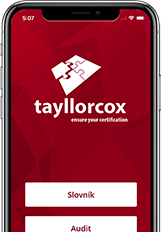What is SCRUM®
The most popular agile management framework. Easy to apply, adapt, project management is faster and more flexible. The latest update in TAYLLORCOX courses focuses even more on creating added value.
Agile Manifesto
It is difficult to imagine how many software or applications were created thanks to the Agile Manifesto
Before "Agile Menifesto", software development was not easy and fast at all. As a result, a number of projects were canceled, others changed at hand so that they ceased to fulfill their original purpose. The Agile Manifest laid the foundation for 12 principles of agile software development.
- Accelerate? development and increase quality
- Streamline collaboration and communication
- Adapt to change, not at the expense of quality and functionality

12 SCRUM principles
1. Communication
The most effective and efficient way to communicate information to the development team from the outside and inside is personal conversation.
2. Motivation
We build projects around motivated individuals. We create an environment for them, we support their needs and we trust them to do a good job.
3. Agile development
We welcome changes in requirements, even in the later stages of development. Agile processes support changes leading to increased customer competitiveness.
4. Quality Software
The highest priority is to satisfy the customer with timely and continuous delivery of valuable software.
5. Effectiveness
The team regularly thinks about how to become more effective, and then corrects and adjusts its behavior and habits.
6. Continuous Improvement
Agile processes support sustainable development. Sponsors, developers and users should be able to keep up the pace.
7. Sprint
We supply working software at intervals of weeks to months, with a preference for shorter periods.
8. Design
Agility is enhanced by the constant attention paid to technical excellence and good design.
9. Lifecycle
Business and development people have to work together daily throughout the project.
10. Architecture
The best architectures, requirements and designs will come from self-organizing teams.
11. Working
The main measure of progress is working software.
12. Simply clever
Simplicity - The art of maximizing the amount of work done is key.
SCRUM Team
Roles, competencies, responsibilities and benefits in agile SCRUM projects
Manager
Although your organization has started managing projects using the Scrum methodology, managers usually do not change their work style. And so there is a reduction in work performance and efficiency. Of course, a lot depends on the situation here: how the role and competence of the manager was set before the introduction of agile management.
Most managers agree that they have much more time than they did before the agile adaptation. They can be in closer contact with their subordinates, better perceive the situation at all stages of the project life cycle, participate in Sprints, standardize best practices into standards, or "best practice", make key decisions across projects.
Managers are responsible for the development of individuals and teams. This is despite the fact that the role of ScrumMaster or Product-Owner is responsible for creating manuals, consulting or coaching. Their perspective is always limited to one product or service. Management from a strategic point of view is always in the hands of the manager.
Ensuring finances and the necessary time for training or conferences for your team, challenges in the form of interesting projects, personal motivation and involvement in professional communities - this is also an integral part of the manager.
But beware! The manager will no longer distribute tasks to individual team members. Proactive assumption of responsibility for performing partial tasks is a fundamental aspect of the self-organized Scrum team. An agile approach to project management requires a change in managerial habits.

Business Analyst
The business analyst must have a sufficient overview of the properties (benefits) of the products, there is no doubt about that. In addition, this business-oriented role requires great communication skills. Thanks to these assumptions, the business analyst is a suitable candidate for the position of Product Owner.
The analyst can be the Product Owner for different teams and help confirm the vision and strategic goals into specific requirements in the form of a Product Backlog for his team (s). A business analyst can help an agile team with the concept of product requirements.
As a member of the team, the main priority is to meet the goals in the implemented Sprints. The analyst also assists in product testing and should be able to answer questions focused on product specifications and benefits in regular Sprint meetings.
These regular activities usually do not neutralize the Business Analytics time to 100%, leaving time for the activities that this role requires (especially the point of transforming visions and strategies into specifications).

Agile Consultant
The consultant is the one who tries to convince others of the benefits of agile management - the Scrum methodology. Motivating a team, and especially managing the benefits of agile principles, can be a long and arduous journey, but if it can, everyone will eventually recognize that the effort was worth it. An Agile consultant, no matter what role he has previously performed, must be able to present how Scrum works.
Whether you decide to make a comprehensive transition to agile management or test it on a smaller project, the Agile Consultant is the one who will spread this vision to all stakeholders on the first agile project.
The Agile Consultant must learn to work with the expectations of others from the use of the Scrum methodology. These expectations are nothing more than requirements for the implementation of Scrum. They help to form the basic framework of the model as well as the definition of roles and competencies.
The consultant must be resistant to disagreements with agile philosophy across the organization. Their goal is to listen and positively influence opinions so that the Scrum methodology is adopted.
Presentation of the basics of Scrum, as well as the transition to a new management system, new roles and competencies, perception of current and future requirements for product development are other prerequisites for a successful Agile consultant.

Team Leader
Team leader most often establishes himself in the role of Team member or ScrumMaster, depending on whether technical or managerial skills predominate. Although most organizations want to have a managerially dominant person in the role of ScrumMaster, this does not mean that Team Leader must automatically become ScruMaster.
On the other hand, there are countless technically proficient Team Leaders who play the role of ScrumMaster excellently. Therefore, the future role of Team Leader cannot be judged by this factor. Much more important is the prerequisites for responsibility, collaboration, and other attributes specified in the ScrumMaster role.
ScrumMaster is expected to encourage the team to collaborate rather than manage it hierarchically. Its goal is to provide other members with their knowledge, rather than looking for answers.
Perhaps the best way to test Team Leader's assumptions for the ScrumMaster position is how he will work. Here it is necessary to realize that the Scrum team is self-organized. The head of the technical department has no role or role here.

Product Manager
Do you work as a Product Manager? Then your role in the agile environment is defined as Product Owner. From the title of this position you have a perfect, resp. detailed overview of product properties and client requirements. Is your product more extensive, resp. has more than one Product Owner? We recommend appointing a Senior Product Owner Role Product Manager to represent the team.
The Product Owner is responsible for defining the strategic form of the product, including its communication. It must have a clear idea of: how and why the final product will look like. He communicates this vision and shares it with the team.
One of the main activities of a Product Owner is to build, manage and prioritize items in the Product Backlog. It does not matter the size of the project, whether he does this activity only for himself or for a wider team. The only thing here here is that it will happen.
While new requests and queries are being created in the Backlog, the Product Owner adds explanations and more detailed information to this database to the extent that all queries are sufficiently explained. A good manager answers questions in person, solves whether there are any problems in communication, helps not only solve problems and also look for alternative solutions.

Tester
The tester usually finds his new role as a functional member of the team. That's because Scrum® prefers to test questions about product properties instead of writing out questions about them, the tester's job is to ask questions.
Agile control Scrum®creates a new channel of communication for Testers about how a product works / should work - with the Product Owner. At the same time, the Tester does not have to limit itself only to inquiring about the Product Owner, but can also talk to end users, customers, resp. with all stakeholders.
It is thus fully in the competence of the Tester to communicate with others, ask questions and look for inconsistencies. This transition to proactive testing is also one of the hallmarks of Scrum®team. Testers, forget that you will wait for someone to give you a list of functional ones to test. Think about what the product should address, how it should work and get to work!

Project Manager
Project team in an agile Scrum environment® does not have the role of project manager. However, this does not mean that the team can get rid of work or responsibility for this role. Due to the fact that self-organization is the basic building block of Scrum, the competence of the project manager is divided into individual roles of the Scrum team.
Without a project manager, the Scrum team will not only do without, but on the contrary - it is the basic philosophy of agile management. Instead of assigning tasks to teams or individuals (classic project management), there is self-responsibility for the areas that are defined in the roles ScrumMaster, Developer, Product Owner. Additional responsibilities are usually mostly transferred to ScrumMaster or Product Owner.
Are you a management type and can you overcome old habits (eg delegating tasks or making decisions for a team) ...? Then ScrumMaster is the perfect role for you. As part of the transformation to agile management, existing project managers are best placed on this new role.
More professionally experienced project managers tend to have a perfect overview of the real needs of their customers. He will best apply his business experience as a Product Owner.

Developer
The role of developers in the Scrum team is to design, design, analyze, program and test products. They have to do everything they have committed to in the Sprint.
One of the most significant changes in the Scrum team is the position of programmers. Although these are professional roles, they are no longer an independent team of professionals waiting to receive an assignment, which they will "write and pass on".
They will never be a separate unit, but on the contrary - developers must be actively involved in the design and specification of requirements. They must be able to comment on proposals, comment on their form, etc. This can be a problem for some of them. Get ready for it. Especially if until then they had worked in a closed community and lived on "their planet"
In addition to communicating with others and commenting on changes, agile development management practices will be new to developers. They must be sufficiently and clearly identified with their role, because they take their share of responsibility in the Scrum team.







